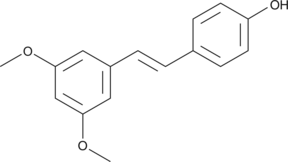Chemicals
Showing 33301–33450 of 41137 results
-
GPR119 (previously designated SNORF25) is an orphan G protein-coupled receptor expressed predominantly in the pancreas and gastrointestinal tract in humans and in the brain, pancreas, and gastrointestinal tract in rodents. It mediates a reduction in food intake and body weight gain in rats upon treatment with oleoyl ethanolamide (OEA), an endogenous, potent agonist for PPARα.{11423,14046} PSN375963 is a potent and selective agonist of GPR119 that shows similar potency to oleoyl ethanolamide (OEA) at both recombinant mouse and human GPR119 receptors, exhibiting EC50 values of 8.4 and 7.9 µM, respectively (EC50 values for OEA are 3.2 and 2.9 µM, respectively).{14046} These data suggest that PSN375963 may be useful as a therapeutic agent for the treatment of obesity.
Brand:CaymanSKU:10008593 - 5 mgAvailable on backorder
GPR119 (previously designated SNORF25) is an orphan G protein-coupled receptor expressed predominantly in the pancreas and gastrointestinal tract in humans and in the brain, pancreas, and gastrointestinal tract in rodents. It mediates a reduction in food intake and body weight gain in rats upon treatment with oleoyl ethanolamide (OEA), an endogenous, potent agonist for PPARα.{11423,14046} PSN632408 is an optimized agonist of GPR119 receptors that shows similar potency to OEA at both recombinant mouse and human GPR119 receptors, exhibiting EC50 values of 5.6 and 7.9 µM, respectively (EC50 values for OEA are 3.2 and 2.9 µM, respectively).{14046} Systemic administration of PSN632408 (30 mg/kg intraperitoneally) suppresses food intake, reduces weight gain, and white adipose tissue deposition in rats.{14046} These data suggest that PSN632408 may be useful as a therapeutic agent for the treatment of obesity.
Brand:CaymanSKU:10008594 - 1 mgAvailable on backorder
GPR119 (previously designated SNORF25) is an orphan G protein-coupled receptor expressed predominantly in the pancreas and gastrointestinal tract in humans and in the brain, pancreas, and gastrointestinal tract in rodents. It mediates a reduction in food intake and body weight gain in rats upon treatment with oleoyl ethanolamide (OEA), an endogenous, potent agonist for PPARα.{11423,14046} PSN632408 is an optimized agonist of GPR119 receptors that shows similar potency to OEA at both recombinant mouse and human GPR119 receptors, exhibiting EC50 values of 5.6 and 7.9 µM, respectively (EC50 values for OEA are 3.2 and 2.9 µM, respectively).{14046} Systemic administration of PSN632408 (30 mg/kg intraperitoneally) suppresses food intake, reduces weight gain, and white adipose tissue deposition in rats.{14046} These data suggest that PSN632408 may be useful as a therapeutic agent for the treatment of obesity.
Brand:CaymanSKU:10008594 - 10 mgAvailable on backorder
GPR119 (previously designated SNORF25) is an orphan G protein-coupled receptor expressed predominantly in the pancreas and gastrointestinal tract in humans and in the brain, pancreas, and gastrointestinal tract in rodents. It mediates a reduction in food intake and body weight gain in rats upon treatment with oleoyl ethanolamide (OEA), an endogenous, potent agonist for PPARα.{11423,14046} PSN632408 is an optimized agonist of GPR119 receptors that shows similar potency to OEA at both recombinant mouse and human GPR119 receptors, exhibiting EC50 values of 5.6 and 7.9 µM, respectively (EC50 values for OEA are 3.2 and 2.9 µM, respectively).{14046} Systemic administration of PSN632408 (30 mg/kg intraperitoneally) suppresses food intake, reduces weight gain, and white adipose tissue deposition in rats.{14046} These data suggest that PSN632408 may be useful as a therapeutic agent for the treatment of obesity.
Brand:CaymanSKU:10008594 - 25 mgAvailable on backorder
GPR119 (previously designated SNORF25) is an orphan G protein-coupled receptor expressed predominantly in the pancreas and gastrointestinal tract in humans and in the brain, pancreas, and gastrointestinal tract in rodents. It mediates a reduction in food intake and body weight gain in rats upon treatment with oleoyl ethanolamide (OEA), an endogenous, potent agonist for PPARα.{11423,14046} PSN632408 is an optimized agonist of GPR119 receptors that shows similar potency to OEA at both recombinant mouse and human GPR119 receptors, exhibiting EC50 values of 5.6 and 7.9 µM, respectively (EC50 values for OEA are 3.2 and 2.9 µM, respectively).{14046} Systemic administration of PSN632408 (30 mg/kg intraperitoneally) suppresses food intake, reduces weight gain, and white adipose tissue deposition in rats.{14046} These data suggest that PSN632408 may be useful as a therapeutic agent for the treatment of obesity.
Brand:CaymanSKU:10008594 - 5 mgAvailable on backorder
PSNCBAM-1 is a cannabinoid (CB) receptor 1 antagonist that is selective for CB1 over CB2 receptors in HEK293 cells overexpressing the human receptors (IC50s = 0.1 and ≥10 µM, respectively, in a GTP binding assay).{42910} PSNCBAM-1 inhibits activation of the human CB1 receptor induced by (±)-CP 55,940 (Item No. 13241), anandamide (AEA; Item No. 90050), and 2-arachidonoyl glycerol (2-AG; Item No. 62160) in yeast expressing human CB1 (IC50s = 45, 37 and 230 nM, respectively). PSNCBAM-1 (30 mg/kg, i.p.) reduces food intake within 2 hours and decreases body weight by 24 hours after administration in male rats.
Brand:CaymanSKU:25855 - 1 mgAvailable on backorder
PSNCBAM-1 is a cannabinoid (CB) receptor 1 antagonist that is selective for CB1 over CB2 receptors in HEK293 cells overexpressing the human receptors (IC50s = 0.1 and ≥10 µM, respectively, in a GTP binding assay).{42910} PSNCBAM-1 inhibits activation of the human CB1 receptor induced by (±)-CP 55,940 (Item No. 13241), anandamide (AEA; Item No. 90050), and 2-arachidonoyl glycerol (2-AG; Item No. 62160) in yeast expressing human CB1 (IC50s = 45, 37 and 230 nM, respectively). PSNCBAM-1 (30 mg/kg, i.p.) reduces food intake within 2 hours and decreases body weight by 24 hours after administration in male rats.
Brand:CaymanSKU:25855 - 10 mgAvailable on backorder
PSNCBAM-1 is a cannabinoid (CB) receptor 1 antagonist that is selective for CB1 over CB2 receptors in HEK293 cells overexpressing the human receptors (IC50s = 0.1 and ≥10 µM, respectively, in a GTP binding assay).{42910} PSNCBAM-1 inhibits activation of the human CB1 receptor induced by (±)-CP 55,940 (Item No. 13241), anandamide (AEA; Item No. 90050), and 2-arachidonoyl glycerol (2-AG; Item No. 62160) in yeast expressing human CB1 (IC50s = 45, 37 and 230 nM, respectively). PSNCBAM-1 (30 mg/kg, i.p.) reduces food intake within 2 hours and decreases body weight by 24 hours after administration in male rats.
Brand:CaymanSKU:25855 - 25 mgAvailable on backorder
PSNCBAM-1 is a cannabinoid (CB) receptor 1 antagonist that is selective for CB1 over CB2 receptors in HEK293 cells overexpressing the human receptors (IC50s = 0.1 and ≥10 µM, respectively, in a GTP binding assay).{42910} PSNCBAM-1 inhibits activation of the human CB1 receptor induced by (±)-CP 55,940 (Item No. 13241), anandamide (AEA; Item No. 90050), and 2-arachidonoyl glycerol (2-AG; Item No. 62160) in yeast expressing human CB1 (IC50s = 45, 37 and 230 nM, respectively). PSNCBAM-1 (30 mg/kg, i.p.) reduces food intake within 2 hours and decreases body weight by 24 hours after administration in male rats.
Brand:CaymanSKU:25855 - 5 mgAvailable on backorder
Psora 4 is an inhibitor of voltage-gated potassium channels (Kv1.3; EC50 = 3 nM).{51189} It is selective for Kv1.3 over Kv1.1, Kv1.2, Kv1.4, Kv1.7, and Kv3.1 channels (EC50s = 62, 49, 202, 100, and 1,500 nM, respectively) but does inhibit the Kv1.5 channel (EC50 = 7.7 nM). Psora 4 selectively binds to the C-type inactivated state of the Kv1.3 channel and inhibits potassium current in a use-dependent manner. It has immunosuppressive activity, inhibiting proliferation of human and rat myelin-specific effector memory T cells in vitro (TEM cells; EC50s = 25 and 60 nM, respectively).
Brand:CaymanSKU:28389 - 1 mgAvailable on backorder
Psora 4 is an inhibitor of voltage-gated potassium channels (Kv1.3; EC50 = 3 nM).{51189} It is selective for Kv1.3 over Kv1.1, Kv1.2, Kv1.4, Kv1.7, and Kv3.1 channels (EC50s = 62, 49, 202, 100, and 1,500 nM, respectively) but does inhibit the Kv1.5 channel (EC50 = 7.7 nM). Psora 4 selectively binds to the C-type inactivated state of the Kv1.3 channel and inhibits potassium current in a use-dependent manner. It has immunosuppressive activity, inhibiting proliferation of human and rat myelin-specific effector memory T cells in vitro (TEM cells; EC50s = 25 and 60 nM, respectively).
Brand:CaymanSKU:28389 - 10 mgAvailable on backorder
Psora 4 is an inhibitor of voltage-gated potassium channels (Kv1.3; EC50 = 3 nM).{51189} It is selective for Kv1.3 over Kv1.1, Kv1.2, Kv1.4, Kv1.7, and Kv3.1 channels (EC50s = 62, 49, 202, 100, and 1,500 nM, respectively) but does inhibit the Kv1.5 channel (EC50 = 7.7 nM). Psora 4 selectively binds to the C-type inactivated state of the Kv1.3 channel and inhibits potassium current in a use-dependent manner. It has immunosuppressive activity, inhibiting proliferation of human and rat myelin-specific effector memory T cells in vitro (TEM cells; EC50s = 25 and 60 nM, respectively).
Brand:CaymanSKU:28389 - 25 mgAvailable on backorder
Psora 4 is an inhibitor of voltage-gated potassium channels (Kv1.3; EC50 = 3 nM).{51189} It is selective for Kv1.3 over Kv1.1, Kv1.2, Kv1.4, Kv1.7, and Kv3.1 channels (EC50s = 62, 49, 202, 100, and 1,500 nM, respectively) but does inhibit the Kv1.5 channel (EC50 = 7.7 nM). Psora 4 selectively binds to the C-type inactivated state of the Kv1.3 channel and inhibits potassium current in a use-dependent manner. It has immunosuppressive activity, inhibiting proliferation of human and rat myelin-specific effector memory T cells in vitro (TEM cells; EC50s = 25 and 60 nM, respectively).
Brand:CaymanSKU:28389 - 5 mgAvailable on backorder
Psoralen is a photoactive probe that has been used to investigate nucleic acid structure and function.{26269} It intercalates into DNA and, when activated by ultraviolet radiation, can create covalent interstrand crosslinks, inducing apoptosis.{26270} Because of its high UV absorbance, psoralen has been combined with UVA light (PUVA therapy) for the treatment of skin problems such as psoriasis.{26268}
Brand:CaymanSKU:11751 - 10 mgAvailable on backorder
Psoralen is a photoactive probe that has been used to investigate nucleic acid structure and function.{26269} It intercalates into DNA and, when activated by ultraviolet radiation, can create covalent interstrand crosslinks, inducing apoptosis.{26270} Because of its high UV absorbance, psoralen has been combined with UVA light (PUVA therapy) for the treatment of skin problems such as psoriasis.{26268}
Brand:CaymanSKU:11751 - 100 mgAvailable on backorder
Psoralen is a photoactive probe that has been used to investigate nucleic acid structure and function.{26269} It intercalates into DNA and, when activated by ultraviolet radiation, can create covalent interstrand crosslinks, inducing apoptosis.{26270} Because of its high UV absorbance, psoralen has been combined with UVA light (PUVA therapy) for the treatment of skin problems such as psoriasis.{26268}
Brand:CaymanSKU:11751 - 25 mgAvailable on backorder
Psoralen is a photoactive probe that has been used to investigate nucleic acid structure and function.{26269} It intercalates into DNA and, when activated by ultraviolet radiation, can create covalent interstrand crosslinks, inducing apoptosis.{26270} Because of its high UV absorbance, psoralen has been combined with UVA light (PUVA therapy) for the treatment of skin problems such as psoriasis.{26268}
Brand:CaymanSKU:11751 - 50 mgAvailable on backorder
Psoralidin is a furanocoumarin isolated from the seeds of P. corylifolia, a medicinal plant found in southeastern Asia, that has been shown to induce cytotoxicity against various cancer cells.{24285} Through TNF-related apoptosis-inducing ligand-mediated events, psoralidin at 50 μM can induce the death of HeLa cancer cells.{24284} It also can induce apoptosis of androgen-dependent (LNCaP, C4-2B) and androgen-independent (DU-145, PC-3) prostate cancer cells and inhibit the growth of PC-3 xenograft tumors in nude mice.{24286}
Brand:CaymanSKU:-Psoralidin is a furanocoumarin isolated from the seeds of P. corylifolia, a medicinal plant found in southeastern Asia, that has been shown to induce cytotoxicity against various cancer cells.{24285} Through TNF-related apoptosis-inducing ligand-mediated events, psoralidin at 50 μM can induce the death of HeLa cancer cells.{24284} It also can induce apoptosis of androgen-dependent (LNCaP, C4-2B) and androgen-independent (DU-145, PC-3) prostate cancer cells and inhibit the growth of PC-3 xenograft tumors in nude mice.{24286}
Brand:CaymanSKU:-Psoralidin is a furanocoumarin isolated from the seeds of P. corylifolia, a medicinal plant found in southeastern Asia, that has been shown to induce cytotoxicity against various cancer cells.{24285} Through TNF-related apoptosis-inducing ligand-mediated events, psoralidin at 50 μM can induce the death of HeLa cancer cells.{24284} It also can induce apoptosis of androgen-dependent (LNCaP, C4-2B) and androgen-independent (DU-145, PC-3) prostate cancer cells and inhibit the growth of PC-3 xenograft tumors in nude mice.{24286}
Brand:CaymanSKU:-Psoralidin is a furanocoumarin isolated from the seeds of P. corylifolia, a medicinal plant found in southeastern Asia, that has been shown to induce cytotoxicity against various cancer cells.{24285} Through TNF-related apoptosis-inducing ligand-mediated events, psoralidin at 50 μM can induce the death of HeLa cancer cells.{24284} It also can induce apoptosis of androgen-dependent (LNCaP, C4-2B) and androgen-independent (DU-145, PC-3) prostate cancer cells and inhibit the growth of PC-3 xenograft tumors in nude mice.{24286}
Brand:CaymanSKU:-PT1 is an activator of AMP-activated protein kinase (AMPK) that directly activates the inactive truncated forms of AMPK monomers α1335, α1394, and α2398 in a dose-dependent manner (EC50s = ~ 8, 8, and 12 µM, respectively).{33404} It stimulates the α1β1γ1 AMPK heterotrimer with an EC50 value of 0.3 μM.{33404} PT1 dose-dependently increases phosphorylation of AMPK and its downstream substrate, acetyl-CoA carboxylase, without increasing the cellular AMP:ATP ratio in L6 myotubes.{33404} In HepG2 liver cells, PT1 lowers lipid content through AMPK activation. PT1 induces autophagy in cardiomyocytes after oxygen glucose deprivation/reoxygenation, resulting in improved cell survival.{33403}
Brand:CaymanSKU:21335 -Out of stock
PT1 is an activator of AMP-activated protein kinase (AMPK) that directly activates the inactive truncated forms of AMPK monomers α1335, α1394, and α2398 in a dose-dependent manner (EC50s = ~ 8, 8, and 12 µM, respectively).{33404} It stimulates the α1β1γ1 AMPK heterotrimer with an EC50 value of 0.3 μM.{33404} PT1 dose-dependently increases phosphorylation of AMPK and its downstream substrate, acetyl-CoA carboxylase, without increasing the cellular AMP:ATP ratio in L6 myotubes.{33404} In HepG2 liver cells, PT1 lowers lipid content through AMPK activation. PT1 induces autophagy in cardiomyocytes after oxygen glucose deprivation/reoxygenation, resulting in improved cell survival.{33403}
Brand:CaymanSKU:21335 -Out of stock
PT1 is an activator of AMP-activated protein kinase (AMPK) that directly activates the inactive truncated forms of AMPK monomers α1335, α1394, and α2398 in a dose-dependent manner (EC50s = ~ 8, 8, and 12 µM, respectively).{33404} It stimulates the α1β1γ1 AMPK heterotrimer with an EC50 value of 0.3 μM.{33404} PT1 dose-dependently increases phosphorylation of AMPK and its downstream substrate, acetyl-CoA carboxylase, without increasing the cellular AMP:ATP ratio in L6 myotubes.{33404} In HepG2 liver cells, PT1 lowers lipid content through AMPK activation. PT1 induces autophagy in cardiomyocytes after oxygen glucose deprivation/reoxygenation, resulting in improved cell survival.{33403}
Brand:CaymanSKU:21335 -Out of stock
PT1 is an activator of AMP-activated protein kinase (AMPK) that directly activates the inactive truncated forms of AMPK monomers α1335, α1394, and α2398 in a dose-dependent manner (EC50s = ~ 8, 8, and 12 µM, respectively).{33404} It stimulates the α1β1γ1 AMPK heterotrimer with an EC50 value of 0.3 μM.{33404} PT1 dose-dependently increases phosphorylation of AMPK and its downstream substrate, acetyl-CoA carboxylase, without increasing the cellular AMP:ATP ratio in L6 myotubes.{33404} In HepG2 liver cells, PT1 lowers lipid content through AMPK activation. PT1 induces autophagy in cardiomyocytes after oxygen glucose deprivation/reoxygenation, resulting in improved cell survival.{33403}
Brand:CaymanSKU:21335 -Out of stock
Nonsense mutations create a premature termination of mRNA translation and have been implicated in various genetic disorders, including muscular dystrophy and cystic fibrosis.{27189} PTC-124 is a nonaminoglycoside that has been reported to selectively induce ribosomes to read through premature nonsense stop signals on mRNA, thus allowing the production of full length, functional proteins.{27189} In a mouse model of cystic fibrosis caused by nonsense mutations, PTC-124 treatment (60 mg/kg s.c. injection or 0.3-0.9 mg/ml orally) has been shown to restore cystic fibrosis transmembrane conductance regulator (CFTR) protein expression and function.{27187} The target activity of PTC-124 was initially evaluated by firefly luciferase reporter cell-based nonsense codon assay (IC50 = 7 nM); however, subsequent assessments using a Renilla reniformis luciferase reporter have failed to produce nonsense codon suppression activity.{27188} Thus, while PTC-124 is in clinical testing in patients with nonsense mutations within the CFTR or dystrophin genes, controversy surrounds its exact mechanism of action.{27189,27188,27191,27190}
Brand:CaymanSKU:-Out of stock
Nonsense mutations create a premature termination of mRNA translation and have been implicated in various genetic disorders, including muscular dystrophy and cystic fibrosis.{27189} PTC-124 is a nonaminoglycoside that has been reported to selectively induce ribosomes to read through premature nonsense stop signals on mRNA, thus allowing the production of full length, functional proteins.{27189} In a mouse model of cystic fibrosis caused by nonsense mutations, PTC-124 treatment (60 mg/kg s.c. injection or 0.3-0.9 mg/ml orally) has been shown to restore cystic fibrosis transmembrane conductance regulator (CFTR) protein expression and function.{27187} The target activity of PTC-124 was initially evaluated by firefly luciferase reporter cell-based nonsense codon assay (IC50 = 7 nM); however, subsequent assessments using a Renilla reniformis luciferase reporter have failed to produce nonsense codon suppression activity.{27188} Thus, while PTC-124 is in clinical testing in patients with nonsense mutations within the CFTR or dystrophin genes, controversy surrounds its exact mechanism of action.{27189,27188,27191,27190}
Brand:CaymanSKU:-Out of stock
Nonsense mutations create a premature termination of mRNA translation and have been implicated in various genetic disorders, including muscular dystrophy and cystic fibrosis.{27189} PTC-124 is a nonaminoglycoside that has been reported to selectively induce ribosomes to read through premature nonsense stop signals on mRNA, thus allowing the production of full length, functional proteins.{27189} In a mouse model of cystic fibrosis caused by nonsense mutations, PTC-124 treatment (60 mg/kg s.c. injection or 0.3-0.9 mg/ml orally) has been shown to restore cystic fibrosis transmembrane conductance regulator (CFTR) protein expression and function.{27187} The target activity of PTC-124 was initially evaluated by firefly luciferase reporter cell-based nonsense codon assay (IC50 = 7 nM); however, subsequent assessments using a Renilla reniformis luciferase reporter have failed to produce nonsense codon suppression activity.{27188} Thus, while PTC-124 is in clinical testing in patients with nonsense mutations within the CFTR or dystrophin genes, controversy surrounds its exact mechanism of action.{27189,27188,27191,27190}
Brand:CaymanSKU:-Out of stock
Nonsense mutations create a premature termination of mRNA translation and have been implicated in various genetic disorders, including muscular dystrophy and cystic fibrosis.{27189} PTC-124 is a nonaminoglycoside that has been reported to selectively induce ribosomes to read through premature nonsense stop signals on mRNA, thus allowing the production of full length, functional proteins.{27189} In a mouse model of cystic fibrosis caused by nonsense mutations, PTC-124 treatment (60 mg/kg s.c. injection or 0.3-0.9 mg/ml orally) has been shown to restore cystic fibrosis transmembrane conductance regulator (CFTR) protein expression and function.{27187} The target activity of PTC-124 was initially evaluated by firefly luciferase reporter cell-based nonsense codon assay (IC50 = 7 nM); however, subsequent assessments using a Renilla reniformis luciferase reporter have failed to produce nonsense codon suppression activity.{27188} Thus, while PTC-124 is in clinical testing in patients with nonsense mutations within the CFTR or dystrophin genes, controversy surrounds its exact mechanism of action.{27189,27188,27191,27190}
Brand:CaymanSKU:-Out of stock
Polycomb complex protein BMI-1 is a polycomb ring finger oncogene that regulates the p16 and p19 cell cycle inhibitor genes. It is necessary for efficient self-renewing cell divisions of stem cells in several tissues and can be over-expressed in tumors. PTC-209 is a BMI-1 inhibitor (IC50 = ~ 0.5 μM) that irreversibly impairs colorectal cancer-initiating cell (CIC) growth.{28288} It reduces tumor growth in CIC xenograft assays and abrogates colorectal cancer cell self-renewal in vivo, reducing their tumorigenic potential.{28288}
Brand:CaymanSKU:-Polycomb complex protein BMI-1 is a polycomb ring finger oncogene that regulates the p16 and p19 cell cycle inhibitor genes. It is necessary for efficient self-renewing cell divisions of stem cells in several tissues and can be over-expressed in tumors. PTC-209 is a BMI-1 inhibitor (IC50 = ~ 0.5 μM) that irreversibly impairs colorectal cancer-initiating cell (CIC) growth.{28288} It reduces tumor growth in CIC xenograft assays and abrogates colorectal cancer cell self-renewal in vivo, reducing their tumorigenic potential.{28288}
Brand:CaymanSKU:-Polycomb complex protein BMI-1 is a polycomb ring finger oncogene that regulates the p16 and p19 cell cycle inhibitor genes. It is necessary for efficient self-renewing cell divisions of stem cells in several tissues and can be over-expressed in tumors. PTC-209 is a BMI-1 inhibitor (IC50 = ~ 0.5 μM) that irreversibly impairs colorectal cancer-initiating cell (CIC) growth.{28288} It reduces tumor growth in CIC xenograft assays and abrogates colorectal cancer cell self-renewal in vivo, reducing their tumorigenic potential.{28288}
Brand:CaymanSKU:-Polycomb complex protein BMI-1 is a polycomb ring finger oncogene that regulates the p16 and p19 cell cycle inhibitor genes. It is necessary for efficient self-renewing cell divisions of stem cells in several tissues and can be over-expressed in tumors. PTC-209 is a BMI-1 inhibitor (IC50 = ~ 0.5 μM) that irreversibly impairs colorectal cancer-initiating cell (CIC) growth.{28288} It reduces tumor growth in CIC xenograft assays and abrogates colorectal cancer cell self-renewal in vivo, reducing their tumorigenic potential.{28288}
Brand:CaymanSKU:-The phosphatidylinositol (PtdIns) phosphates represent a small percentage of total membrane phospholipids. However, they play a critical role in the generation and transmission of cellular signals.{4096,8344} PtdIns-(1,2-dioctanoyl) is a synthetic analog of natural phosphatidylinositol (PtdIns) containing C8:0 fatty acids at the sn-1 and sn-2 positions. The compound features the same inositol and diacyl glycerol (DAG) stereochemistry as that of the natural compound. The short fatty acid chains of this analog, compared to naturally-occurring PtdIns, gives it different physical properties including high solubility in aqueous media. PtdIns are phosphorylated to mono- (PtdIns-P; PIP), di- (PtdIns-P2; PIP2), and triphosphates (PtdIns-P3; PIP3). Hydrolysis of PtdIns-(4,5)-P2 by phosphoinositide (PI)-specific phospholipase C generates inositol triphosphate (IP3) and DAG which are key second messengers in an intricate biochemical signal transduction cascade.
Brand:CaymanSKU:10008099 - 1 mgAvailable on backorder
The phosphatidylinositol (PtdIns) phosphates represent a small percentage of total membrane phospholipids. However, they play a critical role in the generation and transmission of cellular signals.{4096,8344} PtdIns-(1,2-dioctanoyl) is a synthetic analog of natural phosphatidylinositol (PtdIns) containing C8:0 fatty acids at the sn-1 and sn-2 positions. The compound features the same inositol and diacyl glycerol (DAG) stereochemistry as that of the natural compound. The short fatty acid chains of this analog, compared to naturally-occurring PtdIns, gives it different physical properties including high solubility in aqueous media. PtdIns are phosphorylated to mono- (PtdIns-P; PIP), di- (PtdIns-P2; PIP2), and triphosphates (PtdIns-P3; PIP3). Hydrolysis of PtdIns-(4,5)-P2 by phosphoinositide (PI)-specific phospholipase C generates inositol triphosphate (IP3) and DAG which are key second messengers in an intricate biochemical signal transduction cascade.
Brand:CaymanSKU:10008099 - 100 µgAvailable on backorder
The phosphatidylinositol (PtdIns) phosphates represent a small percentage of total membrane phospholipids. However, they play a critical role in the generation and transmission of cellular signals.{4096,8344} PtdIns-(1,2-dioctanoyl) is a synthetic analog of natural phosphatidylinositol (PtdIns) containing C8:0 fatty acids at the sn-1 and sn-2 positions. The compound features the same inositol and diacyl glycerol (DAG) stereochemistry as that of the natural compound. The short fatty acid chains of this analog, compared to naturally-occurring PtdIns, gives it different physical properties including high solubility in aqueous media. PtdIns are phosphorylated to mono- (PtdIns-P; PIP), di- (PtdIns-P2; PIP2), and triphosphates (PtdIns-P3; PIP3). Hydrolysis of PtdIns-(4,5)-P2 by phosphoinositide (PI)-specific phospholipase C generates inositol triphosphate (IP3) and DAG which are key second messengers in an intricate biochemical signal transduction cascade.
Brand:CaymanSKU:10008099 - 500 µgAvailable on backorder
PtdIns-(1,2-dipalmitoyl) is a derivative of phosphatidylinositol (PtdIns) that contains C16:0 fatty acyl chains at the sn-1 and sn-2 positions.
Brand:CaymanSKU:10007710 - 1 mgAvailable on backorder
PtdIns-(1,2-dipalmitoyl) is a derivative of phosphatidylinositol (PtdIns) that contains C16:0 fatty acyl chains at the sn-1 and sn-2 positions.
Brand:CaymanSKU:10007710 - 100 µgAvailable on backorder
PtdIns-(1,2-dipalmitoyl) is a derivative of phosphatidylinositol (PtdIns) that contains C16:0 fatty acyl chains at the sn-1 and sn-2 positions.
Brand:CaymanSKU:10007710 - 500 µgAvailable on backorder
PtdIns-(1,2-dipalmitoyl) is a derivative of phosphatidylinositol (PtdIns) that contains C16:0 fatty acyl chains at the sn-1 and sn-2 positions. PtdIns-(1,2-dipalmitoyl) MaxSpec® standard is a quantitative grade standard of PtdIns-(1,2-dipalmitoyl) (Item No. 10007710) that has been prepared specifically for mass spectrometry and related applications where quantitative reproducibility is required. The solution has been prepared gravimetrically and is supplied in a deactivated glass ampule sealed under argon. The concentration was verified by comparison to an independently prepared calibration standard. This PtdIns-(1,2-dipalmitoyl) MaxSpec® standard is guaranteed to meet identity, purity, stability, and concentration specifications and is provided with a batch-specific certificate of analysis. Ongoing stability testing is performed to ensure the concentration remains accurate throughout the shelf life of the product. Note: The amount of solution added to the vial is in excess of the listed amount. Therefore, it is necessary to accurately measure volumes for preparation of calibration standards. Follow recommended storage and handling conditions to maintain product quality.
Brand:CaymanSKU:31101 - 100 µgAvailable on backorder
The phosphatidylinositol (PtdIns) phosphates represent a small percentage of total membrane phospholipids. However, they play a critical role in the generation and transmission of cellular signals.{16567,16566} PtdIns-(3,4,5)-P3, also known as PIP3, is resistant to cleavage by PI-specific phospholipase C (PLC).{13721} Thus, it is likely to function in signal transduction as a modulator in its own right, rather than as a source of inositol tetraphosphates. PIP3 can serve as an anchor for the binding of signal transduction proteins bearing pleckstrin homology (PH) domains.{5241}{8674} Protein binding to PIP3 is important for cytoskeletal rearrangement and membrane trafficking.{16565} PtdIns-(3,4,5)-P3 (1,2-dihexanoyl) is a synthetic analog of natural PIP3 with C6:0 fatty acids at the sn-1 and sn-2 positions. The compound features the same inositol and diacylglycerol (DAG) stereochemistry as that of the natural compound. The short fatty acid chains of this analog give it different physical properties from naturally-occurring PIP3, including higher solubility in aqueous media.
Brand:CaymanSKU:10008390 - 1 mgAvailable on backorder
The phosphatidylinositol (PtdIns) phosphates represent a small percentage of total membrane phospholipids. However, they play a critical role in the generation and transmission of cellular signals.{16567,16566} PtdIns-(3,4,5)-P3, also known as PIP3, is resistant to cleavage by PI-specific phospholipase C (PLC).{13721} Thus, it is likely to function in signal transduction as a modulator in its own right, rather than as a source of inositol tetraphosphates. PIP3 can serve as an anchor for the binding of signal transduction proteins bearing pleckstrin homology (PH) domains.{5241}{8674} Protein binding to PIP3 is important for cytoskeletal rearrangement and membrane trafficking.{16565} PtdIns-(3,4,5)-P3 (1,2-dihexanoyl) is a synthetic analog of natural PIP3 with C6:0 fatty acids at the sn-1 and sn-2 positions. The compound features the same inositol and diacylglycerol (DAG) stereochemistry as that of the natural compound. The short fatty acid chains of this analog give it different physical properties from naturally-occurring PIP3, including higher solubility in aqueous media.
Brand:CaymanSKU:10008390 - 100 µgAvailable on backorder
The phosphatidylinositol (PtdIns) phosphates represent a small percentage of total membrane phospholipids. However, they play a critical role in the generation and transmission of cellular signals.{16567,16566} PtdIns-(3,4,5)-P3, also known as PIP3, is resistant to cleavage by PI-specific phospholipase C (PLC).{13721} Thus, it is likely to function in signal transduction as a modulator in its own right, rather than as a source of inositol tetraphosphates. PIP3 can serve as an anchor for the binding of signal transduction proteins bearing pleckstrin homology (PH) domains.{5241}{8674} Protein binding to PIP3 is important for cytoskeletal rearrangement and membrane trafficking.{16565} PtdIns-(3,4,5)-P3 (1,2-dihexanoyl) is a synthetic analog of natural PIP3 with C6:0 fatty acids at the sn-1 and sn-2 positions. The compound features the same inositol and diacylglycerol (DAG) stereochemistry as that of the natural compound. The short fatty acid chains of this analog give it different physical properties from naturally-occurring PIP3, including higher solubility in aqueous media.
Brand:CaymanSKU:10008390 - 500 µgAvailable on backorder
The phosphatidylinositol phosphates represent a small percentage of total membrane phospholipids. However, they play a critical role in the generation and transmission of cellular signals.{243,8344} PtdIns-(3,4,5)-P3 can serve as an anchor for the binding of signal transduction proteins bearing pleckstrin homology (PH) domains. Centuarin α and the Akt-family of GTPase activating proteins are examples of PtdIns-(3,4,5)-P3-binding proteins.{5241,8674} Protein-binding to PtdIns-(3,4,5)-P3 is important for cytoskeletal rearrangements and membrane trafficking. PtdIns-(3,4,5)-P3 is resistant to cleavage by PI-specific phospholipase C (PLC). Thus, it is likely to function in signal transduction as a modulator in its own right, rather than as a source of inositol tetraphosphates. For further reading on inositol phospholipids, see also references {3239} and {8672}.
Brand:CaymanSKU:64920 - 1 mgAvailable on backorder
The phosphatidylinositol phosphates represent a small percentage of total membrane phospholipids. However, they play a critical role in the generation and transmission of cellular signals.{243,8344} PtdIns-(3,4,5)-P3 can serve as an anchor for the binding of signal transduction proteins bearing pleckstrin homology (PH) domains. Centuarin α and the Akt-family of GTPase activating proteins are examples of PtdIns-(3,4,5)-P3-binding proteins.{5241,8674} Protein-binding to PtdIns-(3,4,5)-P3 is important for cytoskeletal rearrangements and membrane trafficking. PtdIns-(3,4,5)-P3 is resistant to cleavage by PI-specific phospholipase C (PLC). Thus, it is likely to function in signal transduction as a modulator in its own right, rather than as a source of inositol tetraphosphates. For further reading on inositol phospholipids, see also references {3239} and {8672}.
Brand:CaymanSKU:64920 - 100 µgAvailable on backorder
The phosphatidylinositol phosphates represent a small percentage of total membrane phospholipids. However, they play a critical role in the generation and transmission of cellular signals.{243,8344} PtdIns-(3,4,5)-P3 can serve as an anchor for the binding of signal transduction proteins bearing pleckstrin homology (PH) domains. Centuarin α and the Akt-family of GTPase activating proteins are examples of PtdIns-(3,4,5)-P3-binding proteins.{5241,8674} Protein-binding to PtdIns-(3,4,5)-P3 is important for cytoskeletal rearrangements and membrane trafficking. PtdIns-(3,4,5)-P3 is resistant to cleavage by PI-specific phospholipase C (PLC). Thus, it is likely to function in signal transduction as a modulator in its own right, rather than as a source of inositol tetraphosphates. For further reading on inositol phospholipids, see also references {3239} and {8672}.
Brand:CaymanSKU:64920 - 5 mgAvailable on backorder
The phosphatidylinositol phosphates represent a small percentage of total membrane phospholipids. However, they play a critical role in the generation and transmission of cellular signals.{243,8344} PtdIns-(3,4,5)-P3 can serve as an anchor for the binding of signal transduction proteins bearing pleckstrin homology (PH) domains. Centuarin α and the Akt-family of GTPase activating proteins are examples of PtdIns-(3,4,5)-P3-binding proteins.{5241,8674} Protein-binding to PtdIns-(3,4,5)-P3 is important for cytoskeletal rearrangements and membrane trafficking. PtdIns-(3,4,5)-P3 is resistant to cleavage by PI-specific phospholipase C (PLC). Thus, it is likely to function in signal transduction as a modulator in its own right, rather than as a source of inositol tetraphosphates. For further reading on inositol phospholipids, see also references {3239} and {8672}.
Brand:CaymanSKU:64920 - 500 µgAvailable on backorder
The PtdIn phosphates play an important role in the generation and transduction of intracellular signals.{8344,4096,14518} PtdIns-(3,4,5)-P3-biotin is an affinity probe which allows the PIP3 to be detected through an interaction with the biotin ligand. This design allows PtdIns-(3,4,5)-P3-biotin to serve as a general probe for any protein with a high affinity binding interaction with inositol-(3,4,5)-triphosphate phospholipids, such as phosphatidylinositol 3-kinase, PTEN, or PH-domain-containing proteins.
Brand:CaymanSKU:-The PtdIn phosphates play an important role in the generation and transduction of intracellular signals.{8344,4096,14518} PtdIns-(3,4,5)-P3-biotin is an affinity probe which allows the PIP3 to be detected through an interaction with the biotin ligand. This design allows PtdIns-(3,4,5)-P3-biotin to serve as a general probe for any protein with a high affinity binding interaction with inositol-(3,4,5)-triphosphate phospholipids, such as phosphatidylinositol 3-kinase, PTEN, or PH-domain-containing proteins.
Brand:CaymanSKU:10009531 - 10 µgAvailable on backorder
The PtdIn phosphates play an important role in the generation and transduction of intracellular signals.{8344,4096,14518} PtdIns-(3,4,5)-P3-biotin is an affinity probe which allows the PIP3 to be detected through an interaction with the biotin ligand. This design allows PtdIns-(3,4,5)-P3-biotin to serve as a general probe for any protein with a high affinity binding interaction with inositol-(3,4,5)-triphosphate phospholipids, such as phosphatidylinositol 3-kinase, PTEN, or PH-domain-containing proteins.
Brand:CaymanSKU:10009531 - 100 µgAvailable on backorder
The PtdIn phosphates play an important role in the generation and transduction of intracellular signals.{8344,4096,14518} PtdIns-(3,4,5)-P3-biotin is an affinity probe which allows the PIP3 to be detected through an interaction with the biotin ligand. This design allows PtdIns-(3,4,5)-P3-biotin to serve as a general probe for any protein with a high affinity binding interaction with inositol-(3,4,5)-triphosphate phospholipids, such as phosphatidylinositol 3-kinase, PTEN, or PH-domain-containing proteins.
Brand:CaymanSKU:10009531 - 25 µgAvailable on backorder
The PtdIn phosphates play an important role in the generation and transduction of intracellular signals.{8344,4096,14518} PtdIns-(3,4,5)-P3-biotin is an affinity probe which allows the PIP3 to be detected through an interaction with the biotin ligand. This design allows PtdIns-(3,4,5)-P3-biotin to serve as a general probe for any protein with a high affinity binding interaction with inositol-(3,4,5)-triphosphate phospholipids, such as phosphatidylinositol 3-kinase, PTEN, or PH-domain-containing proteins.
Brand:CaymanSKU:10009531 - 50 µgAvailable on backorder
The phosphatidylinositol (PtdIns) phosphates represent a small percentage of total membrane phospholipids. However, they play a critical role in the generation and transmission of cellular signals.{4096,8344} PtdIns-(3)-P1 (1,2-dioctanoyl) is a synthetic analog of natural PtdIns featuring C8:0 fatty acids at the sn-1 and sn-2 positions. The compound features the same inositol and DAG stereochemistry as the natural compound. PtdIns-(3)-P1 can be phosphorylated to di- (PtdIns-P2; PIP2) and triphosphates (PtdIns-P3; PIP3) by phosphatidyl inositol (PI)-specific kinases.
Brand:CaymanSKU:10008394 - 1 mgAvailable on backorder
The phosphatidylinositol (PtdIns) phosphates represent a small percentage of total membrane phospholipids. However, they play a critical role in the generation and transmission of cellular signals.{4096,8344} PtdIns-(3)-P1 (1,2-dioctanoyl) is a synthetic analog of natural PtdIns featuring C8:0 fatty acids at the sn-1 and sn-2 positions. The compound features the same inositol and DAG stereochemistry as the natural compound. PtdIns-(3)-P1 can be phosphorylated to di- (PtdIns-P2; PIP2) and triphosphates (PtdIns-P3; PIP3) by phosphatidyl inositol (PI)-specific kinases.
Brand:CaymanSKU:10008394 - 100 µgAvailable on backorder
The phosphatidylinositol (PtdIns) phosphates represent a small percentage of total membrane phospholipids. However, they play a critical role in the generation and transmission of cellular signals.{4096,8344} PtdIns-(3)-P1 (1,2-dioctanoyl) is a synthetic analog of natural PtdIns featuring C8:0 fatty acids at the sn-1 and sn-2 positions. The compound features the same inositol and DAG stereochemistry as the natural compound. PtdIns-(3)-P1 can be phosphorylated to di- (PtdIns-P2; PIP2) and triphosphates (PtdIns-P3; PIP3) by phosphatidyl inositol (PI)-specific kinases.
Brand:CaymanSKU:10008394 - 500 µgAvailable on backorder
The phosphatidylinositol (PtdIns) phosphates represent a small percentage of total membrane phospholipids. However, they play a critical role in the generation and transmission of cellular signals.{4096,8344} PtdIns-(4)-P1 (1,2-dioctanoyl) is a synthetic analog of natural phosphatidylinositol (PtdIns) featuring C8:0 fatty acids at the sn-1 and sn-2 positions. The compound contains the same inositol and diacylglycerol (DAG) stereochemistry as the natural compound. PtdIns-(4)-P1 can be phosphorylated to di- (PtdIns-P2; PIP2) and triphosphates (PtdIns-P3; PIP3). Hydrolysis of PtdIns-(4,5)-P2 by phosphoinositide (PI)-specific phospholipase C generates inositol triphosphate (IP3) and DAG which are key second messengers in an intricate biochemical signal transduction cascade.
Brand:CaymanSKU:10007711 - 1 mgAvailable on backorder
The phosphatidylinositol (PtdIns) phosphates represent a small percentage of total membrane phospholipids. However, they play a critical role in the generation and transmission of cellular signals.{4096,8344} PtdIns-(4)-P1 (1,2-dioctanoyl) is a synthetic analog of natural phosphatidylinositol (PtdIns) featuring C8:0 fatty acids at the sn-1 and sn-2 positions. The compound contains the same inositol and diacylglycerol (DAG) stereochemistry as the natural compound. PtdIns-(4)-P1 can be phosphorylated to di- (PtdIns-P2; PIP2) and triphosphates (PtdIns-P3; PIP3). Hydrolysis of PtdIns-(4,5)-P2 by phosphoinositide (PI)-specific phospholipase C generates inositol triphosphate (IP3) and DAG which are key second messengers in an intricate biochemical signal transduction cascade.
Brand:CaymanSKU:10007711 - 100 µgAvailable on backorder
The phosphatidylinositol (PtdIns) phosphates represent a small percentage of total membrane phospholipids. However, they play a critical role in the generation and transmission of cellular signals.{4096,8344} PtdIns-(4)-P1 (1,2-dioctanoyl) is a synthetic analog of natural phosphatidylinositol (PtdIns) featuring C8:0 fatty acids at the sn-1 and sn-2 positions. The compound contains the same inositol and diacylglycerol (DAG) stereochemistry as the natural compound. PtdIns-(4)-P1 can be phosphorylated to di- (PtdIns-P2; PIP2) and triphosphates (PtdIns-P3; PIP3). Hydrolysis of PtdIns-(4,5)-P2 by phosphoinositide (PI)-specific phospholipase C generates inositol triphosphate (IP3) and DAG which are key second messengers in an intricate biochemical signal transduction cascade.
Brand:CaymanSKU:10007711 - 500 µgAvailable on backorder
Pterostilbene is a naturally-occurring dimethyl ether analog of resveratrol that is abundant in blueberries. Like resveratrol, pterostilbene acts as a powerful antioxidant, suppresses the synthesis of prostaglandin E2 from lipopolysaccharide-stimulated human peripheral blood mononuclear cells (IC50 = 1.0 μM for pterostilbene, 3.2 μM for resveratrol), and inhibits cell proliferation (IC50 = ~60 μM for both compounds).{17408,17409,17410} Pterostilbene blocks the activation of ERK1/2, p38 MAPK, and PI3K/Akt signaling pathways, reducing NF-κB and AP-1 transcriptional activation.{17411,17412,17413} Through these actions, pterostilbene evokes effects that prevent cancer, inflammation, and diabetes.
Brand:CaymanSKU:13000 - 100 mgAvailable on backorder
Pterostilbene is a naturally-occurring dimethyl ether analog of resveratrol that is abundant in blueberries. Like resveratrol, pterostilbene acts as a powerful antioxidant, suppresses the synthesis of prostaglandin E2 from lipopolysaccharide-stimulated human peripheral blood mononuclear cells (IC50 = 1.0 μM for pterostilbene, 3.2 μM for resveratrol), and inhibits cell proliferation (IC50 = ~60 μM for both compounds).{17408,17409,17410} Pterostilbene blocks the activation of ERK1/2, p38 MAPK, and PI3K/Akt signaling pathways, reducing NF-κB and AP-1 transcriptional activation.{17411,17412,17413} Through these actions, pterostilbene evokes effects that prevent cancer, inflammation, and diabetes.
Brand:CaymanSKU:13000 - 250 mgAvailable on backorder
Pterostilbene is a naturally-occurring dimethyl ether analog of resveratrol that is abundant in blueberries. Like resveratrol, pterostilbene acts as a powerful antioxidant, suppresses the synthesis of prostaglandin E2 from lipopolysaccharide-stimulated human peripheral blood mononuclear cells (IC50 = 1.0 μM for pterostilbene, 3.2 μM for resveratrol), and inhibits cell proliferation (IC50 = ~60 μM for both compounds).{17408,17409,17410} Pterostilbene blocks the activation of ERK1/2, p38 MAPK, and PI3K/Akt signaling pathways, reducing NF-κB and AP-1 transcriptional activation.{17411,17412,17413} Through these actions, pterostilbene evokes effects that prevent cancer, inflammation, and diabetes.
Brand:CaymanSKU:13000 - 50 mgAvailable on backorder
Pterostilbene is a naturally-occurring dimethyl ether analog of resveratrol that is abundant in blueberries. Like resveratrol, pterostilbene acts as a powerful antioxidant, suppresses the synthesis of prostaglandin E2 from lipopolysaccharide-stimulated human peripheral blood mononuclear cells (IC50 = 1.0 μM for pterostilbene, 3.2 μM for resveratrol), and inhibits cell proliferation (IC50 = ~60 μM for both compounds).{17408,17409,17410} Pterostilbene blocks the activation of ERK1/2, p38 MAPK, and PI3K/Akt signaling pathways, reducing NF-κB and AP-1 transcriptional activation.{17411,17412,17413} Through these actions, pterostilbene evokes effects that prevent cancer, inflammation, and diabetes.
Brand:CaymanSKU:13000 - 500 mgAvailable on backorder
Pteryxin is a coumarin that has been found in A. furcijuga and has diverse biological activities.{46928,46927,46929,46930} It inhibits LPS-induced nitric oxide production in mouse peritoneal macrophages (IC50 = 20 µM).{46928} Pteryxin (100 µg/ml) completely inhibits collagen-induced aggregation of isolated rabbit platelets.{46927} It inhibits butyrylcholinesterase (BChE; IC50 = 12.96 µg/ml).{46929} Pteryxin reduces triacylglycerol levels and expression of the genes encoding sterol regulatory element binding protein 1c (SREBP-1c), fatty acid synthase (FASN), and acetyl-coenzyme A carboxylase 1 (ACC1) in 3T3-L1 adipocytes and HepG2 cells.{46930}
Brand:CaymanSKU:30320 - 10 mgAvailable on backorder
Pteryxin is a coumarin that has been found in A. furcijuga and has diverse biological activities.{46928,46927,46929,46930} It inhibits LPS-induced nitric oxide production in mouse peritoneal macrophages (IC50 = 20 µM).{46928} Pteryxin (100 µg/ml) completely inhibits collagen-induced aggregation of isolated rabbit platelets.{46927} It inhibits butyrylcholinesterase (BChE; IC50 = 12.96 µg/ml).{46929} Pteryxin reduces triacylglycerol levels and expression of the genes encoding sterol regulatory element binding protein 1c (SREBP-1c), fatty acid synthase (FASN), and acetyl-coenzyme A carboxylase 1 (ACC1) in 3T3-L1 adipocytes and HepG2 cells.{46930}
Brand:CaymanSKU:30320 - 25 mgAvailable on backorder
Pteryxin is a coumarin that has been found in A. furcijuga and has diverse biological activities.{46928,46927,46929,46930} It inhibits LPS-induced nitric oxide production in mouse peritoneal macrophages (IC50 = 20 µM).{46928} Pteryxin (100 µg/ml) completely inhibits collagen-induced aggregation of isolated rabbit platelets.{46927} It inhibits butyrylcholinesterase (BChE; IC50 = 12.96 µg/ml).{46929} Pteryxin reduces triacylglycerol levels and expression of the genes encoding sterol regulatory element binding protein 1c (SREBP-1c), fatty acid synthase (FASN), and acetyl-coenzyme A carboxylase 1 (ACC1) in 3T3-L1 adipocytes and HepG2 cells.{46930}
Brand:CaymanSKU:30320 - 5 mgAvailable on backorder
Pteryxin is a coumarin that has been found in A. furcijuga and has diverse biological activities.{46928,46927,46929,46930} It inhibits LPS-induced nitric oxide production in mouse peritoneal macrophages (IC50 = 20 µM).{46928} Pteryxin (100 µg/ml) completely inhibits collagen-induced aggregation of isolated rabbit platelets.{46927} It inhibits butyrylcholinesterase (BChE; IC50 = 12.96 µg/ml).{46929} Pteryxin reduces triacylglycerol levels and expression of the genes encoding sterol regulatory element binding protein 1c (SREBP-1c), fatty acid synthase (FASN), and acetyl-coenzyme A carboxylase 1 (ACC1) in 3T3-L1 adipocytes and HepG2 cells.{46930}
Brand:CaymanSKU:30320 - 50 mgAvailable on backorder
PTI-1 is a synthetic cannabinoid (CB) that contains the 1-pentyl-indole structure found in potent agonists of the central cannabinoid (CB1) receptor, like JWH 018 (Item No. 10900), linked to a thiazole-based side chain. The physiological and toxicological properties of this compound have not been tested. This product is intended for forensic and research applications.
Brand:CaymanSKU:9001948 - 1 mgAvailable on backorder
PTI-1 is a synthetic cannabinoid (CB) that contains the 1-pentyl-indole structure found in potent agonists of the central cannabinoid (CB1) receptor, like JWH 018 (Item No. 10900), linked to a thiazole-based side chain. The physiological and toxicological properties of this compound have not been tested. This product is intended for forensic and research applications.
Brand:CaymanSKU:9001948 - 10 mgAvailable on backorder
PTI-1 is a synthetic cannabinoid (CB) that contains the 1-pentyl-indole structure found in potent agonists of the central cannabinoid (CB1) receptor, like JWH 018 (Item No. 10900), linked to a thiazole-based side chain. The physiological and toxicological properties of this compound have not been tested. This product is intended for forensic and research applications.
Brand:CaymanSKU:9001948 - 5 mgAvailable on backorder
PTIO is an oxidizing reagent that reacts with nitric oxide to form nitric dioxide and corresponding imino nitroxides.{23978} It can be used to assay nitric oxide production when examining nitric oxide synthase inhibitory activity.{7512}
Brand:CaymanSKU:-PTIO is an oxidizing reagent that reacts with nitric oxide to form nitric dioxide and corresponding imino nitroxides.{23978} It can be used to assay nitric oxide production when examining nitric oxide synthase inhibitory activity.{7512}
Brand:CaymanSKU:-PTIO is an oxidizing reagent that reacts with nitric oxide to form nitric dioxide and corresponding imino nitroxides.{23978} It can be used to assay nitric oxide production when examining nitric oxide synthase inhibitory activity.{7512}
Brand:CaymanSKU:-PTIO is an oxidizing reagent that reacts with nitric oxide to form nitric dioxide and corresponding imino nitroxides.{23978} It can be used to assay nitric oxide production when examining nitric oxide synthase inhibitory activity.{7512}
Brand:CaymanSKU:-PTP Inhibitor I is a cell-permeable, protein tyrosine phosphatase (PTP) inhibitor that covalently blocks the catalytic domain of the Src homology region 2 domain-containing phosphatase (SHP-1(ΔSH2)) with a Ki value of 43 µM and PTP1B with a Ki value of 42 µM.{31401} SHP-1 and PTP1B both have known roles in regulating insulin signaling as well as myeloid and lymphoid cell differentiation, making inhibitors of these phosphatases of interest in diabetes, cancer, allergy, and inflammation research.{31658}
Brand:CaymanSKU:19766 -Available on backorder
PTP Inhibitor I is a cell-permeable, protein tyrosine phosphatase (PTP) inhibitor that covalently blocks the catalytic domain of the Src homology region 2 domain-containing phosphatase (SHP-1(ΔSH2)) with a Ki value of 43 µM and PTP1B with a Ki value of 42 µM.{31401} SHP-1 and PTP1B both have known roles in regulating insulin signaling as well as myeloid and lymphoid cell differentiation, making inhibitors of these phosphatases of interest in diabetes, cancer, allergy, and inflammation research.{31658}
Brand:CaymanSKU:19766 -Available on backorder
PTP Inhibitor I is a cell-permeable, protein tyrosine phosphatase (PTP) inhibitor that covalently blocks the catalytic domain of the Src homology region 2 domain-containing phosphatase (SHP-1(ΔSH2)) with a Ki value of 43 µM and PTP1B with a Ki value of 42 µM.{31401} SHP-1 and PTP1B both have known roles in regulating insulin signaling as well as myeloid and lymphoid cell differentiation, making inhibitors of these phosphatases of interest in diabetes, cancer, allergy, and inflammation research.{31658}
Brand:CaymanSKU:19766 -Available on backorder
PTP Inhibitor I is a cell-permeable, protein tyrosine phosphatase (PTP) inhibitor that covalently blocks the catalytic domain of the Src homology region 2 domain-containing phosphatase (SHP-1(ΔSH2)) with a Ki value of 43 µM and PTP1B with a Ki value of 42 µM.{31401} SHP-1 and PTP1B both have known roles in regulating insulin signaling as well as myeloid and lymphoid cell differentiation, making inhibitors of these phosphatases of interest in diabetes, cancer, allergy, and inflammation research.{31658}
Brand:CaymanSKU:19766 -Available on backorder
PTP inhibitor II is a cell-permeable protein tyrosine phosphatase (PTP) inhibitor that covalently binds the catalytic domain of the Src homology region 2 domain-containing phosphatase (SHP-1(ΔSH2)).{31401} PTP inhibitor II binds with lower affinity than PTP Inhibitor I (Item No. 19766) with Ki values of 128 and 43 μM, respectively.{31401} SHP-1 has known roles in regulating insulin signaling as well as myeloid and lymphoid cell differentiation, making inhibitors of these phosphatases of interest in diabetes, cancer, allergy, and inflammation research.{31658}
Brand:CaymanSKU:20629 -Available on backorder
PTP inhibitor II is a cell-permeable protein tyrosine phosphatase (PTP) inhibitor that covalently binds the catalytic domain of the Src homology region 2 domain-containing phosphatase (SHP-1(ΔSH2)).{31401} PTP inhibitor II binds with lower affinity than PTP Inhibitor I (Item No. 19766) with Ki values of 128 and 43 μM, respectively.{31401} SHP-1 has known roles in regulating insulin signaling as well as myeloid and lymphoid cell differentiation, making inhibitors of these phosphatases of interest in diabetes, cancer, allergy, and inflammation research.{31658}
Brand:CaymanSKU:20629 -Available on backorder
PTP inhibitor II is a cell-permeable protein tyrosine phosphatase (PTP) inhibitor that covalently binds the catalytic domain of the Src homology region 2 domain-containing phosphatase (SHP-1(ΔSH2)).{31401} PTP inhibitor II binds with lower affinity than PTP Inhibitor I (Item No. 19766) with Ki values of 128 and 43 μM, respectively.{31401} SHP-1 has known roles in regulating insulin signaling as well as myeloid and lymphoid cell differentiation, making inhibitors of these phosphatases of interest in diabetes, cancer, allergy, and inflammation research.{31658}
Brand:CaymanSKU:20629 -Available on backorder
PTP inhibitor II is a cell-permeable protein tyrosine phosphatase (PTP) inhibitor that covalently binds the catalytic domain of the Src homology region 2 domain-containing phosphatase (SHP-1(ΔSH2)).{31401} PTP inhibitor II binds with lower affinity than PTP Inhibitor I (Item No. 19766) with Ki values of 128 and 43 μM, respectively.{31401} SHP-1 has known roles in regulating insulin signaling as well as myeloid and lymphoid cell differentiation, making inhibitors of these phosphatases of interest in diabetes, cancer, allergy, and inflammation research.{31658}
Brand:CaymanSKU:20629 -Available on backorder






















